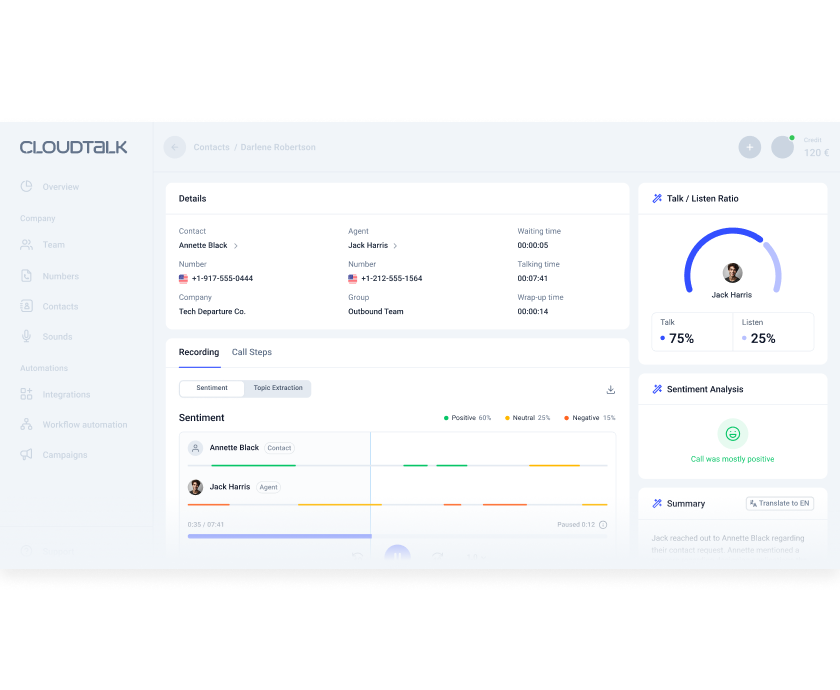What Is Customer Sentiment Analysis? Benefits and How to Measure It

Customers who enjoy positive experiences are likely to spend 140% more than those who don’t and are likely to stay loyal to your brand for 5 years longer.¹
With stats like that, it goes without saying that if you aren’t already, you should be keeping track of how your customers feel. The best way to do that? Customer sentiment analysis.
This handy AI tool tracks the emotion behind the words your customers use—in reviews, emails, chats, calls, and social media. It gives you insight into your customers’ headspace before they churn, complain, or quiet-quit on you.
Keep reading to learn about all of the benefits of customer sentiment analysis, and the best way to measure it.
Key takeaways:
- Spot churn risks early by analyzing customer tone and emotion across calls, chats, and reviews.
- Boost CX and sales with real-time sentiment insights that guide rep responses and strategy.
- Automate what matters — skip manual reviews and get instant, scalable emotion data with AI.
Gain AI-powered call insights.
Use CloudTalk’s customer sentiment analysis to understand and improve performance.
What is Customer Sentiment Analysis?
You’ve just had an argument with your significant other—or at least, you think you did. They said “It’s fine,” but you’re getting major side-eye vibes and now you’re spiraling. If only you could get a read on what’s actually going on inside their head, right?
That’s basically the daily struggle for businesses. You get customer feedback—emails, support tickets, survey comments—but what are your customers really feeling? Are they loyal? Annoyed? About to churn?
That’s where customer sentiment analysis comes in. It’s like emotional radar for your business. Using AI and natural language processing, sentiment analysis scans written or spoken feedback and detects the emotional tone behind it.
Capitalo Breaks Language Barriers with Sentiment Analysis
- Improved rep performance
- Brand consistency across regions
- Expansion into Hungary and Greece

When Capitalo expanded into Germany, they faced a major challenge: no German-speaking supervisor and inconsistent sales rep performance. Without understanding call content, they couldn’t pinpoint why customer satisfaction was slipping.
By adopting CloudTalk’s AI conversation intelligence, they gained instant visibility into customer interactions. AI-powered transcription and sentiment analysis uncovered a key issue—one rep wasn’t fluent in German, hurting communication and trust.
Want to know what your customers are really feeling—before they churn? Unlock real-time sentiment insights with CloudTalk AI.
How Does Customer Sentiment Analysis Work?
You’ve probably had a call like this.
The customer says all the right things — “Thanks, that was helpful” — but something in their tone feels…off. A pause too long. A flatness you can’t quite place. Two days later, they churn.
It’s a tough reminder: it’s not just what customers say that matters, it’s how they say it. And when you’re handling dozens of calls a day, picking up on that manually? Nearly impossible.
Here’s how it works with CloudTalk:
Every time a call ends, CloudTalk’s AI conversation intelligence kicks in. It automatically transcribes the call, analyzes the tone of voice and word choice, and flags the sentiment behind the interaction.
Your team gets instant insight into how the customer felt—and how the rep performed, without manually reviewing a single conversation.
Personalize Customer Interactions
Use real-time sentiment to adapt your tone on the fly. If a customer sounds frustrated, respond with empathy and faster solutions. It shows you understand their mood — and makes interactions feel human, not scripted.
Enhance Retention Strategies
Spot unhappy customers early. If a conversation trends negative, sentiment analysis helps your team step in before that customer churns. Think of it as an early-warning system for loyalty.
Optimize Support Processes
Notice recurring frustration across calls? That’s a red flag. Use sentiment trends to uncover broken workflows, common issues, or script missteps — and fix them before they impact CSAT.
Improve Product Feedback
Want to know how customers really feel about your new feature? Sentiment analysis surfaces common emotional themes in feedback, so your product team can make smarter, faster decisions.

The Benefits of Customer Sentiment Analysis
Customer sentiment analysis isn’t just a nice-to-have — it’s a competitive advantage. By turning emotional cues into data, you can improve everything from customer experience to product development and revenue.
Better Customer Experience
Pinpoint emotional friction before it becomes a problem. Sentiment analysis helps you identify pain points, confusion, or frustration in real time — so your team can respond with empathy and precision. Personalized, emotionally intelligent support leads to happier customers and stronger loyalty.
Sales Optimization
Spot buying signals as they happen — and adjust your pitch accordingly. Whether it’s excitement, hesitation, or doubt, understanding emotional tone helps your reps respond in a way that builds trust and increases close rates.
Ready to use customer emotions as an advantage for your sales team?
Proactive Problem Solving
Don’t wait for issues to explode. With sentiment analysis, you can detect negative trends early—like rising frustration or repeated complaints—and take corrective action before they impact customer relationships or your reputation.
Increased Retention
Want to reduce churn? Start by listening closer. Sentiment analysis helps you understand what makes customers stay (or go), so you can address concerns faster and build the kind of loyalty that lasts.
Data-Driven Decision Making
Ditch the guesswork. By backing your product, support, and CX strategies with sentiment data, you can prioritize improvements that actually matter—and show leadership the “why” behind every decision.
Improved Brand Reputation
Your brand lives in your customers’ emotions. Monitor public sentiment and respond quickly to negative feedback before it snowballs. Sentiment insights help you stay in tune with how your brand is really perceived.
Enhanced Team Performance
Use sentiment insights to coach your team more effectively. From tone to timing, emotional data highlights what works (and what doesn’t)—helping agents improve outcomes and deliver consistently excellent service.
Stop guessing how your customers feel — start acting on it. Unlock the full power of sentiment analysis with CloudTalk.
Customer Sentiment Analysis Use Cases – ADD A VISUAL
Customer sentiment analysis isn’t just a support team thing—it’s a whole business thing. When you understand how your customers feel, you can make sharper decisions, and build better relationships.
From marketing to sales, customer service to product, sentiment insights inform your decisions and enable you to act with empathy—at scale.
Here’s how teams across your org can turn emotion into action—and how CloudTalk’s AI-powered solution makes it happen.
Marketing
Want messaging that actually resonates? Sentiment analysis helps marketers uncover the emotional language customers use when they’re excited, frustrated, or satisfied. By analyzing call data, reviews, and support interactions, you can fine-tune campaigns, nail your tone, and highlight what really matters to your audience.
Pro Tip
Pro Tip: Use CloudTalk to analyze sentiment across customer calls and campaigns — so your marketing team can double down on what resonates, cut what doesn’t, and drive better ROI with every message.
Sales
Sales success hinges on emotional timing. With sentiment analysis, reps can identify buyer hesitation, interest, or urgency in the moment and adjust their pitch accordingly. Whether it’s overcoming objections or knowing when to close, emotional cues give sales teams a strategic edge.
Pro Tip
Pro Tip: With CloudTalk’s AI conversation intelligence, your sales reps get instant access to emotional cues—during or after the call—so they can fine-tune their follow-up, close faster, and never miss a hidden buying signal.
Customer Service
Great support isn’t just about solving the issue—it’s about how the customer feels during the experience. Sentiment analysis helps identify rising frustration, tone shifts, or unresolved tension so agents can course-correct instantly.
Pro Tip
Pro Tip: Let CloudTalk do the heavy lifting—automatically flag negative sentiment trends and surface coaching moments so your team can boost CSAT and deliver consistently better support experiences.
Product Development
Your customers are constantly giving you feedback—even when they’re not filling out surveys. Sentiment analysis helps product teams extract emotional insights from calls, chats, and tickets to understand how users feel about features, pain points, and updates.
Pro Tip
Pro Tip: Use CloudTalk to transform real customer conversations into emotional feedback at scale—so your product team can prioritize what to build next with confidence, not assumptions.
Curious to see how this would look for your team? See for yourself what CloudTalk sentiment analysis is like in action.
How to Measure Customer Sentiment
Customer sentiment is powerful—but only if you know how to measure it. From direct feedback to AI-powered call analysis, there are multiple ways to track how your customers really feel at every stage of their journey.
Below are five proven methods to measure customer sentiment, plus when to use them and how they can work together to give you a full picture of your customer experience.
Surveys and Feedback Forms
Surveys and forms are a classic for a reason—they offer direct input from customers in their own words. Use them after key touchpoints like onboarding, support interactions, or purchases to gather open-ended feedback and ratings.
- Best for: Collecting structured feedback right after an interaction.
- Why it matters: You get first-hand emotional language and context straight from the source.
Call and Chat Analysis
Voice and chat conversations are packed with unfiltered emotional cues—if you know how to find them. With AI-powered tools like CloudTalk’s sentiment analysis, you can automatically transcribe and analyze tone, language, and intent across every customer interaction.
- Best for: Real-time or post-call insights across high-volume communication channels.
- Why it matters: It removes bias, reveals emotional nuance, and gives you scalable, objective sentiment data — without manual review.
Social Media Monitoring
People don’t always say how they feel to you—they say it on social. Monitoring platforms like Twitter, LinkedIn, or Reddit can help you catch mentions, hashtags, and tone shifts around your brand.
- Best for: Gauging public perception and catching real-time buzz (or backlash).
- Why it matters: You stay ahead of trends, identify advocates, and diffuse negative sentiment before it snowballs.
Customer Reviews and Ratings
Whether it’s G2, Trustpilot, or app store reviews, customer ratings reflect raw sentiment about your product or service. Use review sentiment analysis tools to scan emotional language in reviews and track patterns over time.
- Best for: Benchmarking satisfaction across product versions, teams, or markets.
- Why it matters: Reviews give you long-term sentiment trends and insights into product-market fit.
NPS (Net Promoter Score)
NPS is a quality metric that asks one simple question: How likely are you to recommend us to a friend? It’s a quick and effective way to measure customer loyalty and overall satisfaction.
- Best for: Tracking sentiment over time and identifying promoters vs. detractors.
- Why it matters: It helps you segment customers by loyalty and design targeted follow-up strategies.
Ready to stop guessing and start hearing what your customers really feel? Unleash real-time sentiment insights with CloudTalk AI.
How to Improve Your Customer Sentiment
Knowing how your customers feel is powerful — but improving those feelings? That’s where the real growth happens. If you want to turn neutral customers into promoters (and unhappy ones into loyal fans), here are four proven ways to elevate your customer sentiment.
Listen to Your Customers
The first step to improving sentiment is actively listening. Encourage open feedback through surveys, support channels, and even social media — then actually do something with what you hear. Customers feel valued when they know their voices drive real change.
Tip: Use sentiment analysis to spot recurring pain points and close the loop with thoughtful follow-ups.
Train Your Team
Even the best tools can’t replace a well-trained, empathetic team. Train your support and sales reps to recognize emotional cues, respond with care, and de-escalate tense situations. A more emotionally intelligent team = better conversations and better outcomes.
Tip: Use CloudTalk to highlight coaching opportunities based on real customer interactions.
Personalize the Experience
Customers want to feel like more than a ticket number. Use data from past interactions to tailor conversations, offers, and support. From remembering their name to anticipating their needs, personalization can turn a frustrating moment into a memorable one.
Tip: CloudTalk’s AI can help tailor your team’s tone and timing based on real-time sentiment.
Use the Right Tools
You can’t improve what you can’t see. Equip your team with tools that surface emotional signals, flag problem areas, and deliver real-time insights. CloudTalk’s sentiment analysis gives you the visibility you need to take action — fast.
Tip: Automate call analysis to scale emotional intelligence across your entire team.
Your customers are already telling you how they feel — it’s time to start listening.
Your customers are talking — not just with their words, but with their tone, emotion, and intent.
And if you’re not tapping into that emotional layer, you’re missing the full story.
With AI-powered sentiment analysis, you can understand how your customers really feel, act faster, coach smarter, and deliver experiences that actually resonate.
Ready to hear what really matters? Start using CloudTalk’s AI-powered sentiment analysis today.
Sources:
FAQs
How can sentiment analysis be used to improve customer experience?
Customer sentiment analysis identifies emotional cues to resolve issues faster and personalize interactions, improving overall customer experience.
What kind of data can an institution gather from sentiment analysis to improve customer experience?
Sentiment data reveals tone, satisfaction, frustration, and trends—ideal for predictive sentiment analysis and customer experience analysis.
What is sentiment analysis in customer service?
Customer service sentiment analysis uses emotional data from interactions to enhance agent performance and boost satisfaction in real time.
What is an example of a sentiment analysis?
A sentiment analysis example: AI detects frustration in a support call, flags it for follow-up—improving customer retention and resolution time.
What are the three types of sentiment analysis?
Sentiment analysis types: positive, negative, and neutral. Advanced sentiment analytics also detect emotions like anger, joy, or confusion.
What is sentiment analysis in customer reviews?
It’s the automated sentiment analysis of tone in reviews to extract insights on satisfaction, complaints, and consumer sentiment meaning.
How do you calculate customer sentiment?
Use sentiment analytics tools to assign a customer sentiment score based on word choice, tone, and emotional signals across channels.
What is an example of consumer sentiment?
Consumer sentiment example: “The setup was easy, but support was slow.” Mixed tone flags pain points for marketing and product teams.
How much does a customer sentiment analysis tool cost?
Costs vary by features—some offer basic sentiment analytics, while advanced call center sentiment analysis tools start around 19/user/month.





















